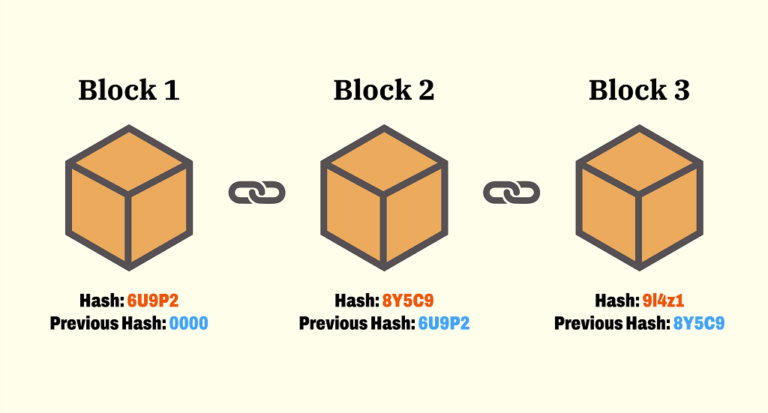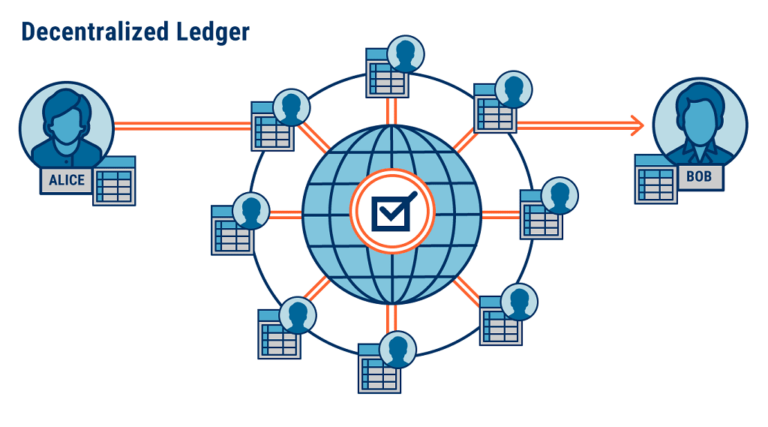Have you ever wondered how a blockchain works, but you are too busy to learn the key components of a blockchain network?
Don’t worry, this article is here to help. This happens to many people often. Besides, what is there not to love about the blockchain ecosystem?
In this article, we will dive into 3 key components of the blockchain network ranging from easy to pro on how a blockchain works.
Table of Contents
Blockchain Networks Explained Simply

Let’s look at the word blockchain.
- Block: a group of data
- Chain: linked together.
- That’s it! A blockchain is a group of data linked together!
Blockchain Technology Basics Expanded

- A Blockchain network is a chain of blocks containing a data structure but secured on a digital ledger, that is linked together on a network by active participants.
- A blockchain is computing power with a function and a distributed database that maintains a continuously growing list of records called blocks. These blocks are linked and secured using cryptography. Each block contains a new transaction of a cryptographic hash of the earlier block, a timestamp, and transaction data without a central manager on a shared ledger.
- It is a distributed ledger blockchain system, in which the transactional record is embedded by the logical components of the block, and all records on the database are connected at once using a physical computer in the mining process components of the blockchain.
A blockchain network is a distributed database or ledger shared between the nodes in a computer network. To function as a distributed ledger basic form, the blockchain ecosystem components are usually managed by a peer-to-peer group that collectively subscribes to a protocol to communicate between the nodes and verify new blocks.
3 Key Components Of
The Blockchain Network – Going Deep
Blockchain technology is a relatively new and complex field, but generally, it can be thought of as a way to securely and transparently store and manage data.
It is composed of three main components:
- Blocks
- Nodes
- Consensus Mechanism
Blocks
A blockchain solution is the individual units of data that are stored in the blockchain. Each block contains a specific amount of data, and they are linked together in a chronological sequence.
Miners secure the blockchain and grant it the property of immutability by attaching a proof-of-work to every block. Once the node app is running, blockchain ecosystem components’ contents are made accessible to users.
The consensus algorithm is implemented as a large part of a node application, providing rules for how the ecosystem arrives at a single representation of the ledger.
Nodes
Nodes are the individual computers or devices that make up the network of the blockchain. Each node maintains a copy of the entire blockchain network, and they work together to verify and validate new data that is added to the network. This ensures that the data in the blockchain is accurate and consistent across all nodes.
Miners maintain the blockchain by maintaining a copy of the blockchain networks and are responsible for creating new blocks. Almost the only way you can attack a peer-to-peer network is by going backward to a few blocks on the blockchain, forking the chain, and starting mining new blocks from there. The new block will have a different public key from the original consensus protocol that the miners agreed on.
More On Blockchain Components
Nodes of the blockchain components would initiate a particular transaction and receive the digital signature for that transaction using the private key. The node verifies the signature, rechecks the answer to the hashcode once it authenticates the details, and it adds the new block in the blockchain technologies.
Consensus Mechanism
This is the mechanism by which the nodes in the network agree on the order and validity of the data that is added to the blockchain. This ensures that the data in the blockchain is accurate and consistent across all nodes.
The consensus is the mechanism by which the nodes in the network legacy systems agree on the order and validity of the data that is added to the blockchain. This is an important part of the blockchain because it ensures that the data in the blockchain is reliable and can be trusted.
Consensus mechanism: A consensus mechanism is a process by which the participants in a blockchain network agree on the state of the ledger. This is necessary because, in a decentralized network, there is no central authority that can enforce the rules and ensure the integrity of the data on the full nodes.
Instead, the network relies on the consensus of its participants to validate transactions and add them to the blockchain as a system flow on other nodes.
There are several different types of consensus mechanisms, including proof of work, proof of stake, and practical byzantine fault tolerance. A decentralized blockchain application where network nodes create cryptographic keys for recording transactions.
In addition to these three main blockchain ecosystem components, the components of blockchain are simple. For example, logical components such as cryptographic hashing are used to convert data into a unique string of characters, and public/private key cryptography is used to securely access and manage data on the blockchain network.
Smart contracts are also an important part of blockchain systems, as they allow for the automatic execution of hash code agreements without the need for intermediaries in the node application.
Cryptography is the practice of secure communication in the presence of third parties. In a blockchain network, cryptography is used to secure transactions and protect the integrity of the data of the blockchain code at a fixed length.
This is achieved through the use of digital signatures in core groups in blockchain ecosystems, which are unique mathematical codes that are associated with each user in the network. Digital signatures of multiple blocks allow users to securely sign and verify transactions, ensuring that only authorized users can access and modify the data in the blockchain.
Consensus Algorithms
As a result, the consensus algorithm can guarantee that all the blocks coming into a multi-node blockchain network are verified, providing safety. Every upgrade made on it is added to the blockchain ecosystem only after a consensus has been reached between all participating nodes/peers in the network.
Once a block is added to the chain that has my first transaction on it, all the nodes update the chain to reflect that I do not own 1 bitcoin anymore.
Can A Blockchain Secure Data?
Yes, blockchain technology can be used to secure data. A blockchain ecosystem is a distributed database that consists of a chain of blocks, each of which contains a record of multiple transactions.
Can A Blockchain Store Data?
Yes, the components of blockchain are to house data. Each block is linked to the previous block in the chain, using a cryptographic hash function. This creates a secure distributed ledger, a tamper-evident record of all the transactions that have occurred on the blockchain.
What Is The Vital Component Of A Blockchain?
Of course, it can, a blockchain ecosystem can be used to store data. A blockchain is a distributed database that consists of a chain of blocks, each of which contains a record of multiple transactions.
Each block is linked to the previous block in the chain, using a cryptographic hash function.
Can A Blockchain Record Financial Transactions?
It can do that too! One of the key features of a blockchain is that it is a decentralized and distributed database, which means that it is not controlled by a single entity but rather is maintained by a network of computers that work together to validate and record transactions.
Do I Have To Be A Computer Science Guru To Use Blockchain?
Many people use blockchain technology daily without having a deep understanding of how it works. For example, individuals who use cryptocurrency wallets to send and receive digital assets are using blockchain technology, but they may not necessarily need to know the technical details of how it works.
What Is A Public Blockchain
Blockchain operations use a pair of keys (a public key and a private key) to encrypt and decrypt data. This allows users to securely access and manage their data on the public blockchain.
What Is A Private Blockchain?
Private blockchain architecture is often used by organizations that want to use blockchain technology to store and manage data but do not want to make that data publicly available. They are also sometimes used for applications that require a high level of privacy, such as currency transactions or supply chain management. Most components of blockchain are not private.
What Are Virtual Machines?
Virtual machines work by creating a hash code on a virtualized version of the hardware that a computer uses to run the software and the components of the blockchain.
These machines have several advantages over physical computers. For example, they allow users to run multiple operating systems on a single physical machine, which can be useful for testing and development purposes.
Overall, a virtual machine is a powerful tool that can be used to run multiple operating systems and applications on a single physical machine.
What Is The Ethereum Virtual Machine?
The Ethereum Virtual Machine (EVM) is a runtime environment for smart contracts in the Ethereum blockchain.
Most importantly is that the EVM is designed to be lightweight and efficient, and it is implemented in several programming languages, including C++, Go, and Rust.
Are Financial Institutions Using Blockchains?
Smart contracts: These are self-executing contracts with the terms of the agreement between buyer and seller being directly written into lines of code. This allows for the automatic execution of the contract without the need for intermediaries.
More components of blockchain are peer-to-peer (P2P) network is a networks+
of computers that communicate and collaborate directly, without the need for a central server or authority.
This allows the network to operate without a central authority and ensures that the data is available and accessible to all users.
Blockchain networks have the potential to revolutionize a wide range of industries by providing a secure, transparent, and tamper-proof way to track and verify the transaction process.
The Bottom Line
In summary, the three key components of blockchain networks are cryptography, consensus algorithms, and peer-to-peer network hash codes. Large technology companies such as the Linux Foundation are using it too.






